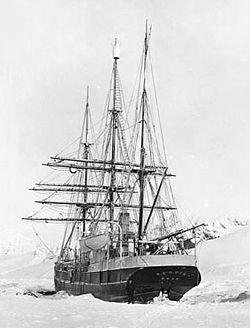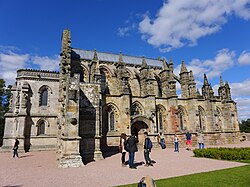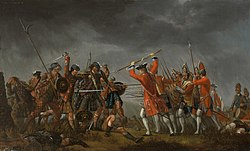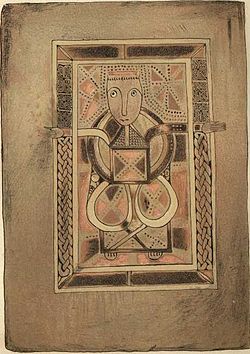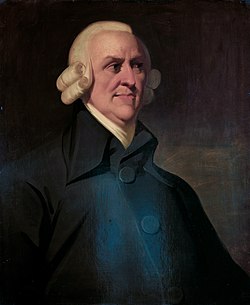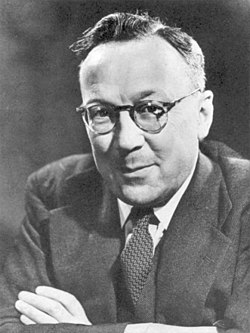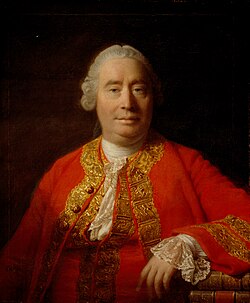
Back بوابة:إسكتلندا Arabic Портал:Шотландия Bulgarian Portál:Skotsko Czech Πύλη:Σκωτία Greek Portal:Escocia Spanish Atari:Eskozia Basque Portail:Écosse French Portal:Escocia Galician Portale:Scozia Italian Portal:Szkocja Polish
| Main Page | Selected articles 1 | Selected articles 2 | Selected biographies | Selected quotes | Selected pictures | Featured Content | Categories & Topics |
Introduction
 |

|
|
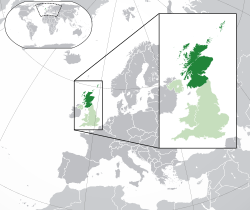
| ||
Scotland is a country that is part of the United Kingdom. It contains nearly one-third of the United Kingdom's land area, consisting of the northern part of the island of Great Britain and more than 790 adjacent islands, principally in the archipelagos of the Hebrides and the Northern Isles. To the south-east, Scotland has its only land border, which is 96 miles (154 km) long and shared with England; the country is surrounded by the Atlantic Ocean to the north and west, the North Sea to the north-east and east, and the Irish Sea to the south. The population in 2022 was 5,439,842. Edinburgh is the capital and Glasgow is the most populous of the cities of Scotland.
The Kingdom of Scotland emerged as an independent sovereign state in the 9th century. In 1603, James VI succeeded to the thrones of England and Ireland, forming a personal union of the three kingdoms. On 1 May 1707, Scotland and England combined to create the new Kingdom of Great Britain, with the Parliament of Scotland subsumed into the Parliament of Great Britain. In 1999, a Scottish Parliament was re-established, and has devolved authority over many areas of domestic policy. The Scottish Government is the executive arm of the devolved government, headed by the first minister who chairs the cabinet and responsible for government policy and international engagement. Further powers are devolved to local government from the Scottish Government to the country's 32 subdivisions (known as "council areas").
The country has its own distinct legal system, education system and religious history, which have all contributed to the continuation of Scottish culture and national identity. Scottish English and Scots are the most widely spoken languages in the country, existing on a dialect continuum with each other. Scottish Gaelic speakers can be found all over Scotland, however the language is largely spoken natively by communities within the Hebrides; Gaelic speakers now constitute less than 2% of the total population, though state-sponsored revitalisation attempts have led to a growing community of second language speakers.
The mainland of Scotland is broadly divided into three regions: the Highlands, a mountainous region in the north and north-west; the Lowlands, a flatter plain across the centre of the country; and the Southern Uplands, a hilly region along the southern border. The Highlands are the most mountainous region of the British Isles and contain its highest peak, Ben Nevis, at 4,413 feet (1,345 m). The region also contains many lakes, called lochs; the term is also applied to the many saltwater inlets along the country's deeply indented western coastline. The geography of the many islands is varied. Some, such as Mull and Skye, are noted for their mountainous terrain, while the likes of Tiree and Coll are much flatter.
Selected article
Selected quotes
In the news

- 16 April 2025 – Transgender rights in the United Kingdom, For Women Scotland Ltd v The Scottish Ministers
- The Supreme Court of the United Kingdom rules that legal gender is based upon biological sex for the purposes of the Equality Act 2010. (BBC News)
Selected biography
Selected picture

Meall a' Bhùiridh and Lochan na h-Achlaise on Rannoch Moor viewed from the A82 en route to Glen Coe in the HIghlands..
Photo credit: Fuzzy14

Eilean Glas Lighthouse, built by engineer Thomas Smith, was one of the original four lights to be commissioned by the Commissioners of the Northern Lights and the first in the Hebrides (the others were Kinnaird Head, Mull of Kintyre and North Ronaldsay).
Photo credit: Richard Baker

The Queensferry Crossing (formerly the Forth Replacement Crossing) is a road bridge in Scotland. It was built alongside the existing Forth Road Bridge and the Forth Bridge. It carries the M90 motorway across the Firth of Forth between Edinburgh, at South Queensferry, and Fife, at North Queensferry.
Photo credit: Greg Fitchett

Sunrise over Ben Vorlich , a mountain in the Southern Highlands and Loch Tay, the largest body of fresh water in Perth and Kinross.
Photo credit: Michal Klajban

The Black Cuillin, a range of rocky mountains located on the Isle of Skye, viewed from Sgùrr na Strì.
Photo credit: User:YaoAxton
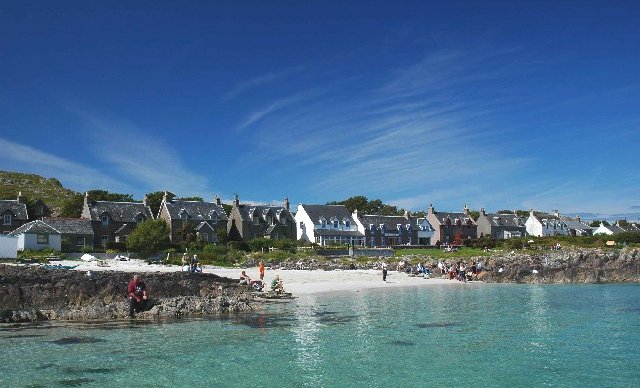
Iona (Scottish Gaelic: Ì Chaluim Chille) is a small island in the Inner Hebrides off the western coast of Scotland. It was a centre of Celtic Christianity for four centuries and is today renowned for its tranquility and natural beauty. It is a popular tourist destination.
Photo credit: Graham Proud
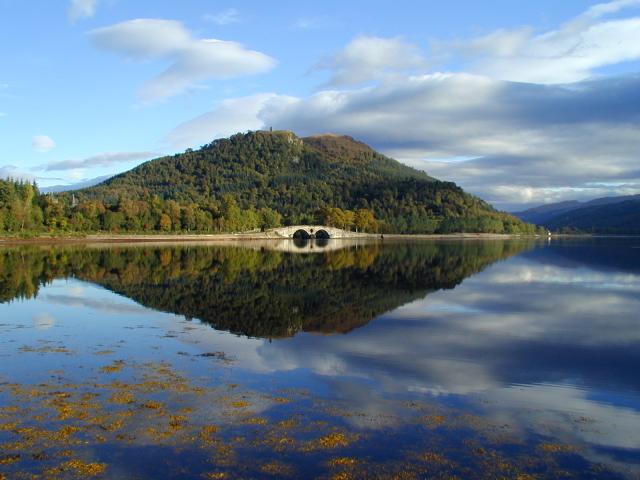
Loch Fyne (Scottish Gaelic: Loch Fìne, meaning "Loch of the Vine or Wine", is a sea loch on the west coast of Argyll and Bute. Although there is no evidence for grapes growing there, it was more metaphorical, such as meaning that the River, Abhainn Fìne, was a well-respected river.
Photo credit: Michael Parry

Limestone carving of Scotland's heraldic lion above the entrance to the Queen's Gallery, Edinburgh
Photo credit: Stefan2901

Holyrood Palace is the official residence of the British monarch in Scotland. Located at the bottom of the Royal Mile in Edinburgh, at the opposite end to Edinburgh Castle, Holyrood has served as the principal royal residence in Scotland since the 16th century, and is a setting for state occasions and official entertaining.
Photo credit: Christoph Strässler

Barra Airport (Scottish Gaelic: Port-adhair Bharraigh) (IATA: BRR, ICAO: EGPR) (also known as Barra Eoligarry Airport) is a short-runway airport (or STOLport) situated in the wide shallow bay of Traigh Mhòr at the north tip of the island of Barra in the Outer Hebrides, Scotland. The airport is unique, being the only one in the world where scheduled flights use a beach as the runway.
Photo credit: Steve Holdsworth

Edinburgh Castle is a fortress which dominates the skyline of the city of Edinburgh, from its position atop the volcanic Castle Rock. Human habitation of the site is dated back as far as the 9th century BC, although the nature of early settlement is unclear. There has been a royal castle here since at least the reign of King David in the 12th century, and the site continued to be a royal residence until the Union of the Crowns in 1603.
Photo credit: Saffron_Blaze

The Scott Monument is a Victorian Gothic monument to Scottish author Sir Walter Scott (not to be confused with the National Monument). It stands in Princes Street Gardens in Edinburgh.
Photo credit: Schatir

Bealach na Bà is a historic pass through the mountains of the Applecross peninsula, in Wester Ross in the Scottish Highlands—and the name of a famous twisting, single-track mountain road through the pass and mountains. The road is one of few in the Scottish Highlands that is engineered similarly to roads through the great mountain passes in the Alps, with very tight hairpin bends that switch back and forth up the hillside.
Photo credit: Stefan Krause

The Glasgow Necropolis is a Victorian cemetery in Glasgow. It sits on a hill above, and to the east of, St. Mungo's Cathedral. It was conceived as a Père Lachaise for Glasgow, and subsequently established by the Merchants' House of Glasgow in 1831. Fifty thousand individuals have been buried in approximately 3500 tombs.
Photo credit: Finlay McWalter

The National Museum of Scotland is one of Scotland's national museums, on Chambers Street, in Edinburgh. The original Royal Museum began in the 19th century and was added to in the 1990s when a new building known as The Museum of Scotland was added, both merging in 2007 into The National Museum of Scotland.
Photo credit: Shimgray

Reaper is a restored historic Fifie herring drifter which is registered by the National Historic Ships Committee as part of the Core Collection of historic vessels in the UK, and currently operates as a museum ship.
Photo credit: Scottish Fisheries Museum Boats Club

Dunfermline Abbey is a large Benedictine abbey in Dunfermline, Fife. It was administered by the Abbot of Dunfermline. The abbey was founded in 1128 by King David I, but the monastic establishment was based on an earlier foundation dating back to the reign of King Máel Coluim mac Donnchada (i.e. "Malcolm III" or "Malcolm Canmore", r. 1058-93).
Photo credit: Andy Stephenson

A crannóg (pronounced /krəˈno:g/ or /ˈkrɑno:g/ or /ˈkranag/) is an ancient artificial island or natural island found in Scotland and Ireland, used for a settlement. The name may also refer to a wooden platform erected on shallow loch floors.
Photo credit: Dave Morris

The Royal Burgh of Haddington is a town in East Lothian. It is the main administrative, cultural and geographical centre for East Lothian, which was known officially as Haddingtonshire before 1921. It lies approximately 20 miles (32 km) east of Edinburgh.
Photo credit: Richard Webb
Did You Know...

- ... that contrary to Shakespeare's play, Macbeth was not killed during the Battle of Dunsinane?
- ... that John Neilson, a Scottish immigrant to Lower Canada, became a major publisher and bookseller, and was reportedly "the largest consumer of paper" in the country?
- ... that today the Bishop of Edinburgh plays a ceremonial role at the coronation of Charles III and Camilla as a representative of the Walker Trustees?
- ... that the 2024 Hillhead by-election was the first by-election won by the Scottish Green Party?
- ... that Prince Philip was the first member of the British royal family to fly in a helicopter?
- ... that Julia Dawson's first Clarion Van was named for Scottish socialist Caroline Martyn?
- ... that Scottish bricklayer Brian Higgins was unable to find work for 25 years after appearing on a construction-industry blacklist?
- ... that William of Littlington opposed the division of England and Scotland into two Carmelite provinces in 1303, was excommunicated, and did four years' penance in Paris?
Get involved
For editor resources and to collaborate with other editors on improving Wikipedia's Scotland-related articles, see WikiProject Scotland.
To get involved in helping to improve Wikipedia's Scotland related content, please consider doing some of the following tasks or joining one or more of the associated Wikiprojects:
- Visit the Scottish Wikipedians' notice board and help to write new Scotland-related articles, and expand and improve existing ones.
- Visit Wikipedia:WikiProject Scotland/Assessment, and help out by assessing unrated Scottish articles.
- Add the Project Banner to Scottish articles around Wikipedia.
- Participate in WikiProject Scotland's Peer Review, including responding to PR requests and nominating Scottish articles.
- Help nominate and select new content for the Scotland portal.
Do you have a question about The Scotland Portal that you can't find the answer to?
Post a question on the Talk Page or consider asking it at the Wikipedia reference desk.
Related portals
Other language versions
Associated Wikimedia
The following Wikimedia Foundation sister projects provide more on this subject:
-
Commons
Free media repository -
Wikibooks
Free textbooks and manuals -
Wikidata
Free knowledge base -
Wikinews
Free-content news -
Wikiquote
Collection of quotations -
Wikisource
Free-content library -
Wikispecies
Directory of species -
Wikiversity
Free learning tools -
Wikivoyage
Free travel guide -
Wiktionary
Dictionary and thesaurus





